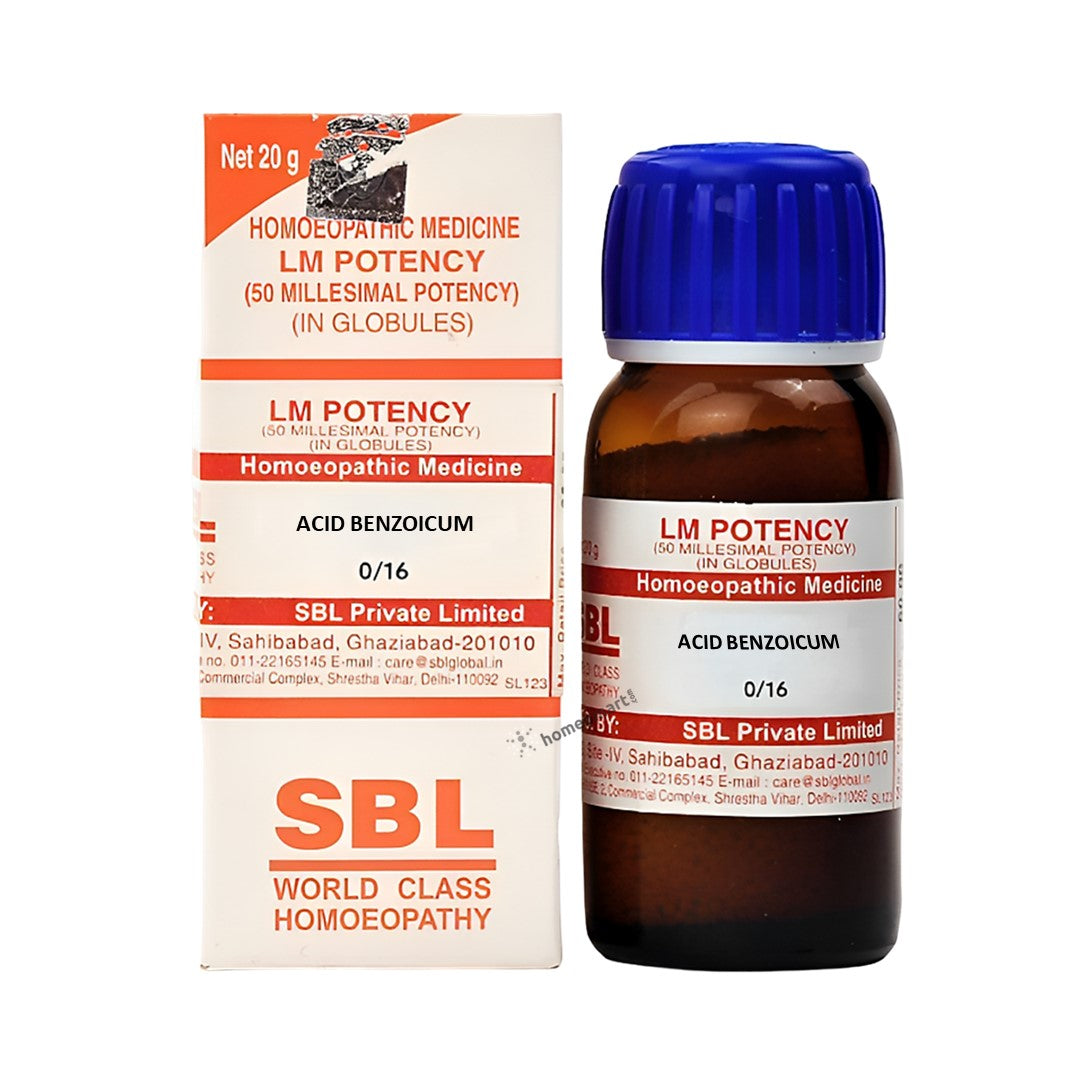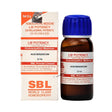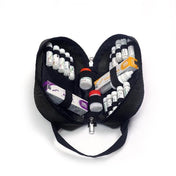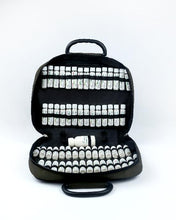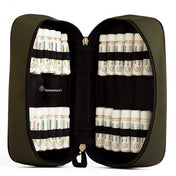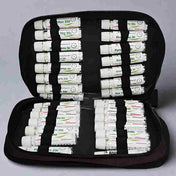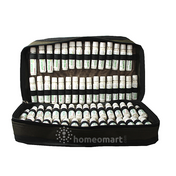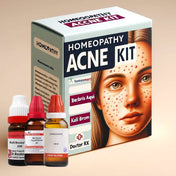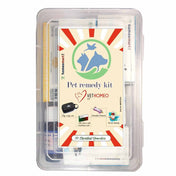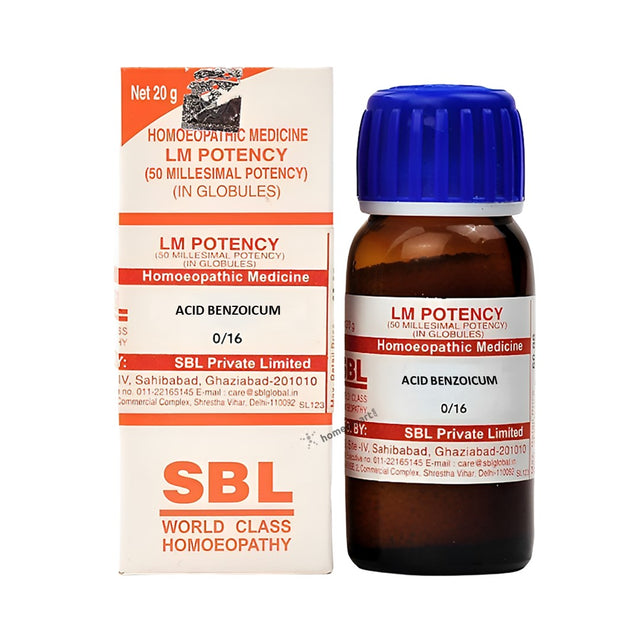Acidum Benzoicum LM Potency Homeopathy Dilution
Acidum Benzoicum LM Potency Homeopathy Dilution - 1/2 dram (1.6 Gms) / 0/1 is backordered and will ship as soon as it is back in stock.
Couldn't load pickup availability
Description
Description
For urinary disorders such as inflammation of the bladder, painful urination and frequent urgey to urinate, Corrects discoloration of the urine with foul smell, treatment of rheumatic and arthritic pain, ulcers in the mouth and provides relief from sore throat, diarrhea, reduce high body temperature and corrects itchy spots on the skin
Indications for Acidum Benzoicum LM Potency Homeopathy Dilution:
The remedy is characterized by distinct symptoms related to the odor and color of the urine, as well as its pronounced effect on metabolism. It is particularly effective for individuals with uric acid diathesis, presenting symptoms such as highly colored and offensive urine, and various gouty manifestations. This remedy is also indicated for renal insufficiency and exhibits unique behaviors, such as children wanting to be nursed in arms and refusal to be laid down, as well as pains that suddenly change location. It is known for its anti-sycotic properties, making it beneficial for treating both gouty and asthmatic conditions.
Mental and Emotional Symptoms
- Mental State: The patient has a tendency to dwell on unpleasant past events. This can lead to feelings of depression and a noticeable tendency to omit words while writing.
Head and Facial Symptoms
- Head: Vertigo with a tendency to fall sideways, throbbing in the temporal arteries causing puffiness around the ears, and noise sensations while swallowing. The remedy is also effective for ulcerations of the tongue and swelling behind the ears, accompanied by cold sweat on the forehead, and pricking, puckered constriction of the mouth with bluish and bleeding gums. Presence of wens is noted.
- Nose: Itching of the septum and pain in the nasal bones.
- Face: Copper-colored spots, redness with small blisters, and circumscribed redness of the cheeks.
Gastrointestinal Symptoms
- Stomach: Sweating while eating, pressure in the stomach, and a sensation of a lump.
- Abdomen: Cutting pain around the navel and stitching sensations in the liver region.
- Rectum and Stool: Stitches and a constricted feeling, puckering constriction of the rectum, itching, and watery elevations around the anus. Stools are frothy, offensive, liquid, light-colored, and resemble soapsuds, often accompanied by windy bowel movements.
Urinary Symptoms
- Urine: The urine has a repulsive odor and changeable color, often brown and acidic. Symptoms include enuresis, dribbling, and offensive urine particularly in older men, with an excess of uric acid, vesical catarrh from suppressed gonorrhea, and cystitis.
Respiratory Symptoms
- Respiratory System: Morning hoarseness, asthmatic cough worse at night and when lying on the right side, chest tenderness, and pain in the region of the heart. The expectoration is typically green mucus.
Musculoskeletal Symptoms
- Back: Pressure on the spinal column, coldness in the sacrum, and dull pain in the region of the kidneys, exacerbated by wine.
- Extremities: Joints crack on motion, tearing pain with stitches, pain in the tendo Achillis, rheumatic gout with painful nodes and gouty deposits. Conditions include ganglion, wrist swelling, knee pain and swelling, bunion of the great toe, and tearing pain in the great toe.
Fever and Skin Symptoms
- Fever: Cold hands, feet, back, and knees, chilliness, cold sweat, and internal heat upon awakening.
- Skin: Red spots and itching in specific areas.
Modalities and Relationships
- Modalities: Symptoms worsen in open air and by uncovering.
- Relationships: The remedy is useful after Colchic fails in gout and after Copaiva in gonorrhea. Comparable remedies include Nitric acid, Ammon benz, Sabina, and Tropoeolum (Garden Nasturtium - known for fetid urine).
- Antidote: Copaiva.
- Incompatibility: Wine exacerbates symptoms.
Dosage
- Recommended Potency: Third to sixth potency.
About LM potency homeopathy medicines
In the sixth edition of ‘Organon,’ Dr. Hahnemann introduced a new system of dilution and potentization and called it “renewed dynamisation” with a diluting ratio of 1:50,000. It was named 50 millesimal potency or LM potency by Dr. Pierre Schmidt. In some parts of the world, it is also called Q potency. It soon got professional acceptance. To date, it is recognized by different homoeopathic pharmacopoeias including American and Indian.
What are they and how are they denoted?
These homoeopathic potencies are prepared in the diluting scale of 1:50,000 and denoted as 0/1, 0/2, 0/3…..etc. They are generally used up to 0/30.
Perceived advantages
- Highest development of power at each potency level.
- Mildest reaction – no medicinal aggravation.
- Frequent repetition is permitted; every hour or often in urgent cases.
- Quick cure in chronic cases where it can be given daily or often.
- 0/3 is more subtle than 30C or 200C and the 0/30 is sharper than CM as believed by many classical homoeopaths.
LM potency dosage: Generally LM potencies are administered as follows:
- Take a 4oz (120ml) to 6oz (180ml) clean glass bottle. Fill it 3/4th with water. Take 1 or 2 globules of the desired potency (often starting at LM 0/1) and place it into the bottle.
- Succuss the bottle just before ingestion 1 to 12 times depending on the sensitivity of the patient. This slightly raises the potency and activates the remedy.
- Take 1, or more teaspoons of the medicinal solution and place it into 8 to 10 tablespoons of water in a dilution glass and stir it. Most cases are started with 1 teaspoon and the amount is increased only if necessary. In children, the amount should be 1/2 teaspoon. Infants may only need 1/4 of a teaspoon.
The dosage of the medicinal solution can be carefully adjusted to suit the sensitivity of the individual’s constitution
Note: We dispense SBL LM potency medicines in 1/2, 1 & 2 dram plastic containers, image for illustrative purposes only.


